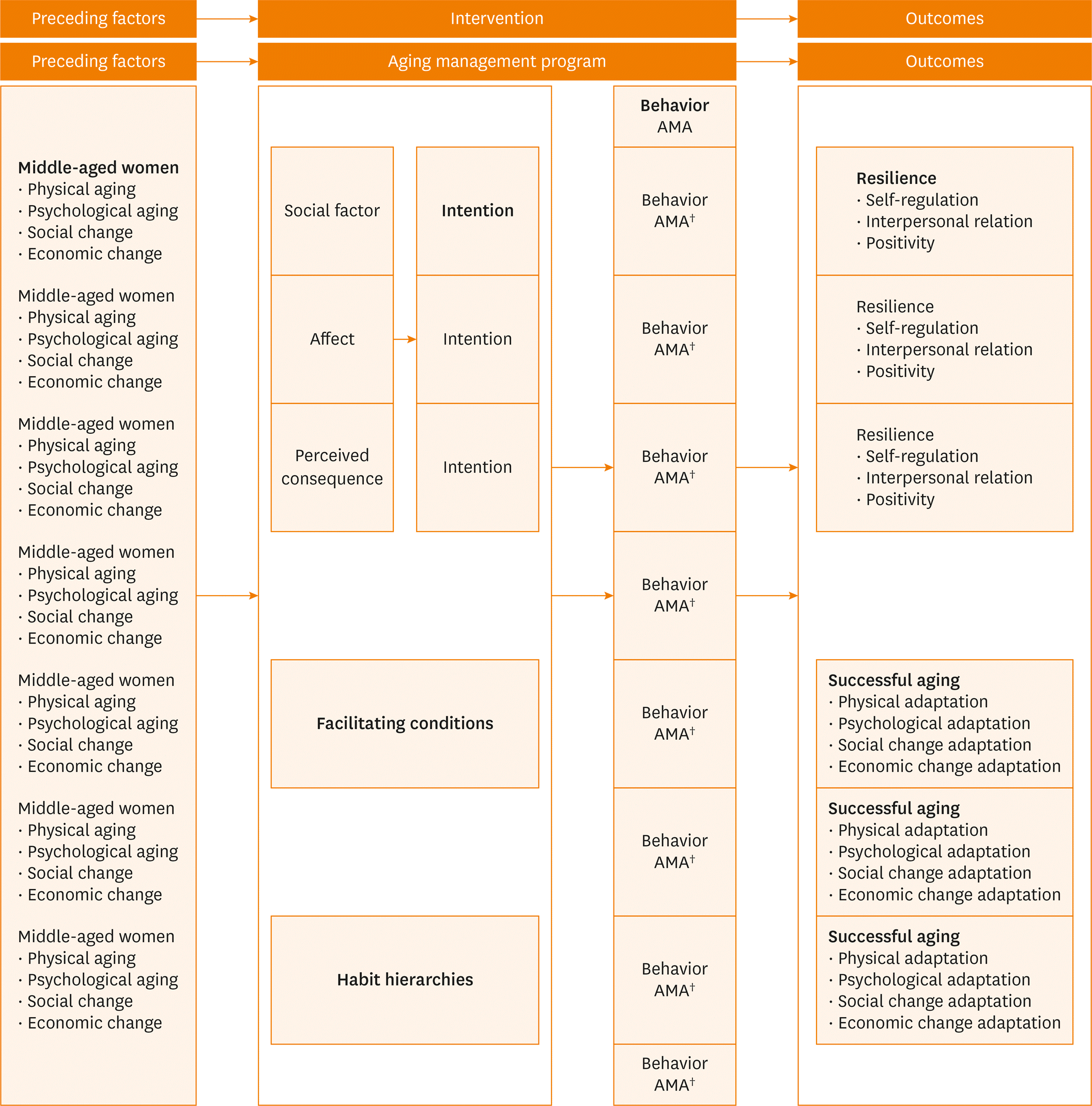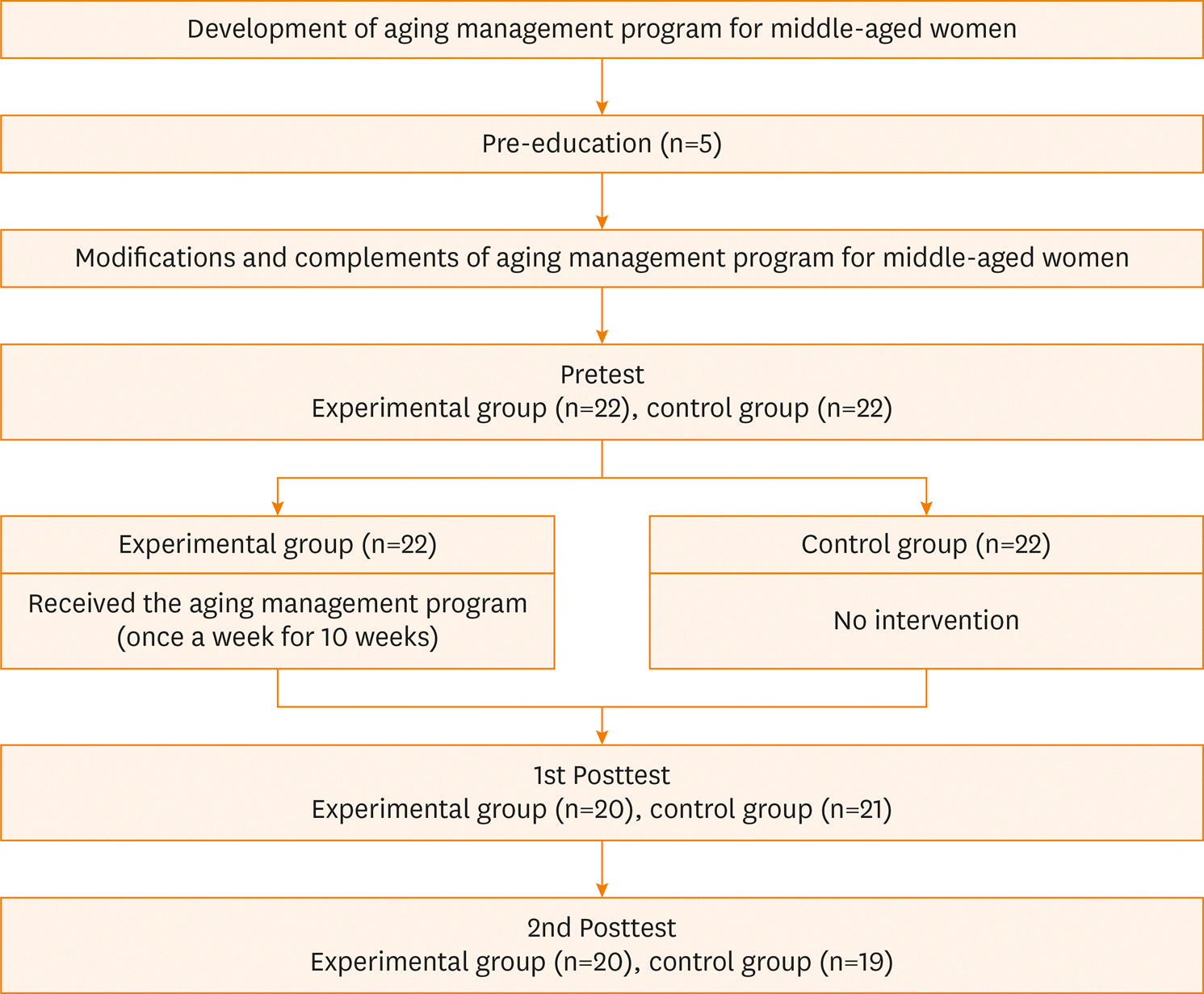Abstract
Purpose
The purpose of this study was to examine the effects of an aging management program on the resilience and successful aging of middle-aged women.
Methods
A quasi-experimental study with a non-equivalent control and pre-post test design was used. The participants were 39 middle-aged women living in urban areas in Korea. The experimental group (n=22) received the aging management program for a total of 10 weeks, 90 minutes to 120 minutes per week. The aging management program consisted of strategies to enhance the behavior, promotion conditions, and habits of the program, including various activities for middle-aged women. The data were analyzed using χ2 tests, independent t-tests, and repeated measures analysis of variance with the SPSS/WIN 21.0 program.
Results
The resilience score of the experimental group was significantly higher level than the score of the control group in the time-to-group interactions (F=3.70, p=0.029). The successful aging score of the experimental group was significantly higher than the score of the control group in the time-to-group interactions (F=5.86, p=0.004). However, the sub-hypotheses of resilience (self-regulation and interpersonal relationships) and successful aging (physical aging adaptation and psychological age adaptation) were partially accepted.
Conclusions
The aging management program for middle-aged women was identified as an effective intervention for promoting resilience and successful aging in middle-aged women. Therefore, this suggests that the aging care program could be a useful intervention program to improve the mental health of middle-aged women living in communities.
REFERENCES
1.Statistics Korea. Statistical indicators [Internet]. Daejeon: Statistics Korea;2016. [cited 2018 Oct 2]. Available from:. https://meta.narastat.kr/metasvc/index.do?confmNo=101035&inputYear=2017.
2.Yang KM. The effect of depression, life stress and resilience on quality of life in middle aged women. Journal of Korean Academic Society of Home Care Nursing. 2015. 22(2):300–309.
3.Lee MS., Ju YA. A study on the effectiveness of group counselling program for middle-aged women's life quality improvement. Journal of Lifelong Education. 2016. 22(3):87–116.
4.Kim JS., Park SA. The change of physical conditions and family relationship demonstrated in <The Hwa-jang> and <The Menopause of My Elder Sister> written by Kim Hoon: The focus of identity crisis of middle age and the prospectus of the late life. Family and Culture. 2013. 25(4):120–151.
5.Ahn JS. A study on perception of successful aging in adult developmental stages [dissertation]. Busan: Donga University;2010. p. 169.
7.Shin WY., Kim MG., Kim KH. Developing measures of resilience for Korean adolescents and testing cross, convergent, and discriminant validity. Studies on Korean Youth. 2009. 20(4):105–131.
8.Yun WJ. A study on the mediating effect of resilience in the relationship between physical self-concept and life satisfaction of middle-aged women participating in life sport. Journal of Korean Physical Education Association for Girls and Women. 2017. 31(4):1–19. CROSSREF.
9.Connor KM., Davidson JR. Development of a new resilience scale: the Connor-Davidson Resilience Scale (CD-RISC). Depression and Anxiety. 2003. 18(2):76–82.

10.Coronado PJ., Oliva A., Fasero M., Piñel C., Herraiz MA., Pérez-López FR. Resilience and related factors in urban, mid-aged Spanish women. International Menopause Society. 2015. 18(6):867–872.

11.Aldwin CM., Igarashi H. Successful, optimal, and resilient aging: a psychosocial perspective. Lichtenberg PA, Mast BT, Carpenter BD, Wetherell J, editors. editors.APA handbook of clinical geropsychology. Vol. 1: history and status of the field and perspectives on aging. Washington, D.C.: American Psychological Association;2015. p. 331–359.

12.Lally P., Van Jaarsveld CH., Cornelia HM., Potts HW., Wardle J. How are habits formed: modelling habit formation in the real world. European Journal of Social Psychology. 2010. 40(6):998–1009. CROSSREF.

13.Triandis HC. Values, attitudes and interpersonal behaviour. Howe HE, editor. editor.Nebraska symposium on motivation: beliefs, attitudes and values. Lincoln: University of Nebraska Press;1980. p. 195–259.
14.Sarrel PM. Evaluation and management of postmenopausal patients. The Female patient. 1995. 20:27–32.
15.Jo HS., Lee KJ. A comparative study on climacteric symptoms of natural menopausal women and artificial menopausal women. Journal of Korean Academy of Nursing. 2001. 31(4):692–702. CROSSREF.

16.Jung HY., Sung KM. The development of healthy aging scale for middle aged women: convergent approach. Journal of Digital Convergence. 2018. 16(5):361–372. CROSSREF.
17.Byun YC., Lee DH., Yoo HS. Effect of chronic dance sports activity on ego-resilience, subjective happiness and balance in elderly women. Korean Society of Sport Psychology. 2014. 25(1):39–50.
18.Verplanken B., Aarts H. Habit, attitude, and planned behavior: Is habit an empty construct or an interesting case of goal-directed automaticity? European Review of Social Psychology. 2011. 10(1):101–134. CROSSREF.
19.Kang G., Oh S. Effects of Mindfulness Meditation program on perceived stress, ways of coping, and stress response in breast cancer patients. Journal of Korean Academy of Nursing. 2012. 42(2):161–170.

20.Lee SM. The effect of appreciation of artworks at gallery on adult's stress level and resilience [master's thesis]. Seoul: Dongguk University;2017. p. 150.
21.Kwon G., Cho S. A study on factors affecting the rumor acceptance and diffusion behavior: an application of Triandis Model. Journal of Public Relations Research. 2017. 21(5):27–63. CROSSREF.
22.Oh HS. Development and test of the hypothetical model to explain smoking cessation behaviors based on Triandis' interpersonal behavior theory. Journal of Korean Academy of Nursing. 2002. 32(1):16–27. CROSSREF.

23.Park MH., Park EA., Cheon SM. Effect of integrated arts therapy on ego-resilience of middle-aged women and stress coping strategies. Journal of Arts Psychotherapy. 2017. 13(3):21–42.
24.Kim AR., Song SY., Lee HS. Effects of the core stability exercise on pain, muscle strength, and physical balance of middle aged women with back pain. Korean Association of Certified Exercise Professionals. 2013. 38:60.
25.Seo MS., Choi BG., Yun SY. Effects of horticultural activity on stress and happiness in mothers with middle school students. Journal of People, Plants, and Environment. 2013. 16(2):53–59. CROSSREF.

26.Jung HS. The effect of painting appreciation collective art therapy making use of logotherapy on the meaning of life and psychological comfort of the middle-aged women [master's thesis]. Gwangju: Chosun University;2017. p. 172.
Table 1.
The Contents of Aging Management Program for Middle-aged Women
Table 2.
Characteristics of the Participants (N=39)
| Characteristics | Categories | Total | Experimental (n=20) | Control (n=19) | t/χ2 | p |
|---|---|---|---|---|---|---|
| n(%) | n(%) | n(%) | ||||
| Age (year)† | 45–50 | 18 (46.2) | 9 (45.0) | 9 (47.3) | 15.38 | .424 |
| 51–55 | 14 (35.9) | 6 (30.0) | 8 (42.2) | |||
| 56–59 | 7 (17.9) | 5 (25.0) | 2 (10.5) | |||
| M±SD | 51.79±4.33 | 52.35±5.35 | 51.21±3.47 | 0.81 | .419 | |
| Husband’s age | 45–50 | 10 (25.7) | 5 (25.0) | 5 (26.3) | 20.05 | .330 |
| 51–55 | 15 (38.4) | 9 (45.0) | 6 (31.6) | |||
| 56–59 | 14 (35.9) | 6 (30.0) | 8 (42.1) | |||
| M±SD | 54.23±5.03 | 54.40±5.57 | 54.05±4.55 | 0.21 | .833 | |
| Monthly income (10,000 won) | 100–199 | 8 (20.5) | 2 (10.0) | 6 (31.6) | 6.08 | .193 |
| 200–299 | 9 (23.1) | 5 (25.0) | 4 (21.0) | |||
| 300–399 | 10 (25.6) | 7 (35.0) | 3 (15.8) | |||
| 400–499 | 10 (25.6) | 4 (20.0) | 6 (31.6) | |||
| ≥500 | 2 (5.1) | 2 (10.0) | 0 (0) | |||
| Education level† | Middle school | 4 (9.8) | 3 (15.0) | 1 (4.8) | 3.44 | .179 |
| High school | 23 (48.8) | 15 (75.0) | 8 (38.1) | |||
| College | 12 (41.5) | 2 (10.0) | 10 (57.1) | |||
| Marital satisfaction† | Unsatisfactory | 5 (12.8) | 2 (10.0) | 3 (15.8) | 0.46 | .928 |
| Normal | 18 (46.2) | 9 (45.0) | 9 (47.4) | |||
| Satisfaction | 14 (35.9) | 8 (40.0) | 6 (31.5) | |||
| Very satisfactory | 2 (5.1) | 1 (5.0) | 1 (5.3) | |||
| Occupation† | Housewife | 26 (66.7) | 15 (75.0) | 11 (57.8) | 2.25 | .521 |
| Office worker | 6 (15.4) | 3 (15.0) | 3 (15.8) | |||
| Technician | 1 (2.6) | 0 (0) | 1 (5.3) | |||
| Professionals | 6 (15.4) | 2 (10.0) | 4 (21.1) |
Table 3.
Effects of Aging Care Program for Middle-aged Women (N=39)




 PDF
PDF ePub
ePub Citation
Citation Print
Print




 XML Download
XML Download